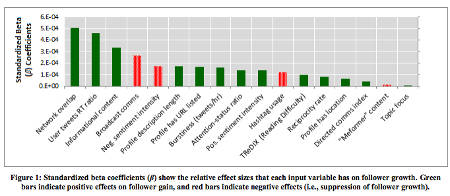//Kevin Anderson /March 1 / 2013
The message matters: The science of gaining more followers on Twitter
Every publisher and editor wants to know how to increase their social media following, but up until now, adding more followers on Twitter and Facebook seemed more art than science, despite plentiful advice from social media agencies and experts trying to sell their services. Now, thanks to an academic study in the US, we have a bit more science on how to attract new followers.
Researchers from the Georgia Institute of Technology and the University of Michigan looked at “507 Twitter users and a half-million of their tweets over 15 months” and took into consideration “(behavioural), content, and network data” to answer the question of what drives growth in Twitter followers.
The study, which is available in PDF form, found:
- “Message content significantly impacts follower growth.” If you’re negative, your follower numbers will go down, but “expressing positive sentiment” helps grow your number of followers.
- One finding supports the common advice that you should fill out your profile completely.
- Good writing helps, and the study found that readability will help increase your following as well. “When deciding whether or not to follow a virtual stranger, we found Twitter users seek out well-written over poorly written content,” CJ Hutto from the Georgia Institute of Technology and one of the authors of the study told New Scientist.
- In good news for news organisations, “informational content attracts new followers”.
That’s what you should do to increase followers, but the study also found some practices to avoid unless you want to send your follower numbers plummeting.
- Be careful that the tweets don’t stray into simple promotion of your news organisation. The study drew a contrast between “Informers, those who share informational content” and “Meformers, those who share content about themselves”. The report found “Meformers were reported to have almost three times fewer followers than Informers.”
- Don’t clutter your tweets with multiple hashtags. Hashtags can be useful to combine tweets about a single event or ongoing story, such as an election campaign. However, one hashtag will do instead of three.
- The study also found that “broadcast communications” rather than directed communications have a negative impact on your follower count too. It’s important to put this finding in context for news organisations, which often use their primary accounts to share their content very much in a broadcast manner. These accounts often have a lot of followers. One key finding from BBC research is that editorial choice, even for their main BBC-branded accounts, is important. Simply using your Twitter or other social networking accounts to broadcast all of your stories isn’t the most effective use of social media.
However, for individual journalists, it is clear from internal research at MSN network and the BBC that for journalists’ accounts, they have much higher levels of engagement and interaction and also have a stronger and larger network. This interaction – comments, questions and responses – is what the study means by directed communication. Individual journalists need to remember to act as individuals rather than headline services for their own content.
Of course, Twitter use does vary across cultures. What strategies have you tried that have helped you gain the following you have? Were there any techniques that you used that you believe cost you followers? What differences have you found in how Twitter or other social networks are used in your culture? Share your tips in the comments.
Article by Kevin Anderson


Leave your comment